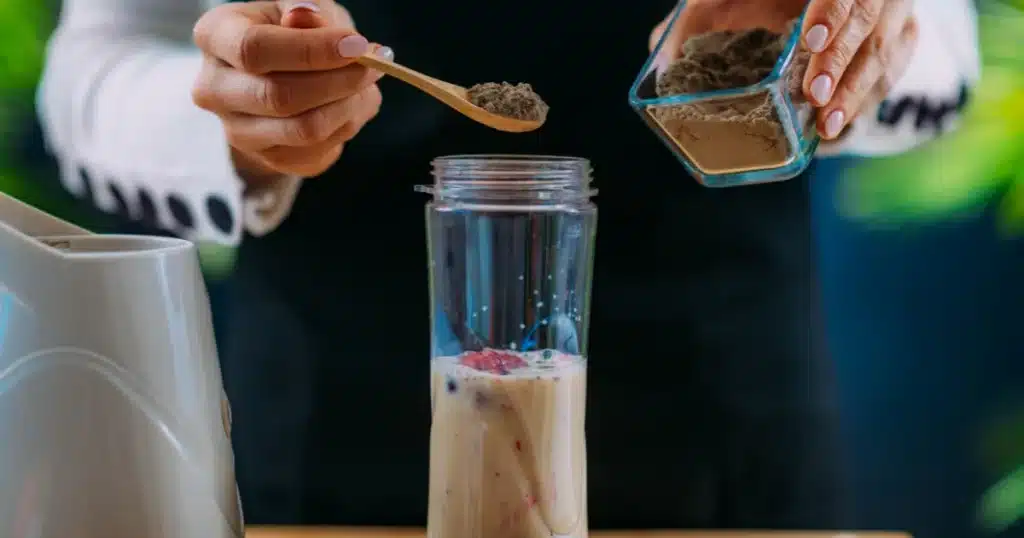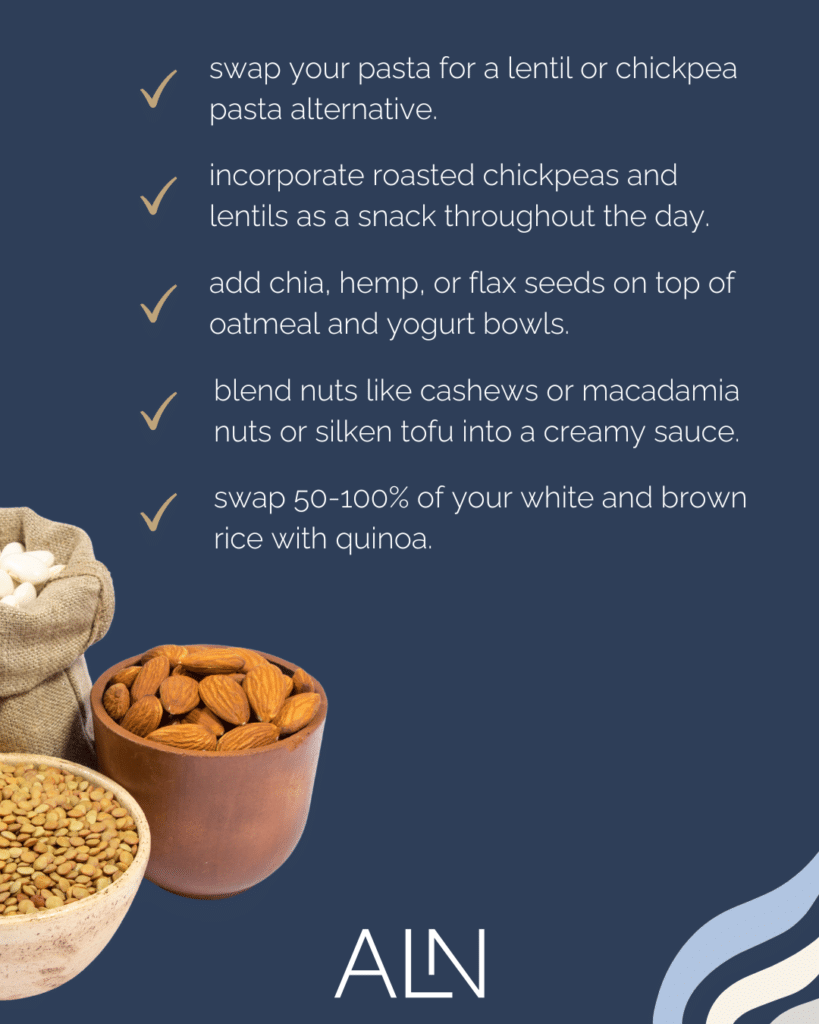RUNNING →
Level Up Your Nutrition Game With Our Freebies
Alex
I provide nutrition coaching for endurance athletes to improve performance and body composition through a simple and flexible eating style.
Hi, I'm
ATHLETE EATING GUIDE →
PROTEIN →
TRIATHLON →
RECIPES →
PERFORMANCE NUTRITION →
SUPPLEMENTS →
HOLIDAY & TRAVEL →
PLANT-BASED →
FEMALE ATHLETE NUTRITION
Explore the Blog
LEARN MORE →
ATHLETE GROCERY SHOPPING GUIDE →
RACE DAY: TRIATHLON NUTRITION PLANNER →
READY TO FUEL?
incredible value!
The fueling guide bundle serves as your one-stop-shop for strategies to fueling before, during and after your workouts.
ENDURANCE EATS
BINGE-WATCH READY!
YOUTUBE SERIES

Plant-based protein has been a popular topic among endurance athletes in recent years. Protein is an important macronutrient for sports performance and recovery. With more athletes choosing to eat a plant-centric diet, it is important to have an understanding about plant protein options.
This includes the benefits and potential side effects of plant protein and how it may impact athletic performance. In today’s article, we will be exploring these questions around plant-based protein and the role it has in sports nutrition. We also go over five easy ways to add more plant protein in your daily diet.
If you haven’t already, make sure to check out our complete blog post on plant-based athletes and what they need to know! It contains tons of tangible tips for being a successful plant-based endurance athlete.
What is Plant Protein?
Plant protein is a food that contains a meaningful amount of protein found in certain plants. Unlike animal protein, plant protein isn’t derived from animal sources. People who eat a plant-based diet rely solely on plant protein, while other omnivore athletes may eat a mix of plant and animal sources.
Sources of plant-based protein include soy (tofu, tempeh, edamame, soy milk), lentils, chickpeas, beans, nuts, seeds, and some grains (like quinoa).
Are Plant Proteins Complete?
A complete protein is a protein that contains all nine essential amino acids. Amino acids (AA) are the building blocks of protein and while your body produces some, others need to be ate through your diet.
Animal products are a complete source of protein, including eggs, meat, and poultry, but not all plant proteins are. A few complete plant proteins are soy products, pea protein, and quinoa. Other plants may contain certain amino acids, but not others.
An easy way to make sure you are getting all your amino acids is to eat a variety of plant proteins throughout the day. Two plant proteins that when combined together give you all nine amino acids are called complementary proteins.
For example, legumes are low in AA methiodine and high in AA lysine. Seeds are high in methiodine and low in lysine. If you eat lentils and seeds together, you will get an sufficient amount of all the amino acids you need!
Are Plant Proteins Harder to Digest?

A common concern with plant proteins is that they are harder to digest than animal protein. The digestibility of plant protein will depend on its structure and presence of fiber. Soy, for example, is a plant protein that is typically digested easily by most.
Some plant-based proteins are higher in dietary fiber, which are carbohydrate fibers that go undigested in your digestive tract. Because of this, foods like legumes and beans may take longer to digest because of their high fiber content.
However, fiber isn’t inherently bad and is actually important to maintain overall digestive health. If you notice any GI symptoms after eating high-fiber foods, it is recommended to start with smaller portion sizes and slowly increase. You should also make sure you are drinking enough water to help everything move smoothly through you.
Keep in mind: you may find it is helpful to limit high fiber foods before your workout or training session. Some athletes report GI discomfort after eating a pre-workout meal with too much fiber in it!
Side Effects of Plant-based Protein Powder

Another way to get plant-based protein is to use a plant-derived protein powder. Popular options include pea, hemp, chia, and brown rice protein, with many brands mixing a few together.
Protein powders can be a great way to get supplemental protein if you are having trouble with whole-food sources alone. They can be added to smoothies, oatmeal, pancakes, shakes, and more to boost the protein content.
You may be curious about the side effects of plant-based protein powders. Overall, everyone will tolerate protein powders differently. Some athletes report better digestibility of plant protein powders over whey protein, especially if they have a sensitivity to lactose. On the flip side, the higher fiber content of plant protein may cause GI discomfort in some, as we talked about above.
To limit side effects of any protein powder, avoid consuming them in excess and trial and error a few brands until you find one that works for you.
5 Easy Ways to Get in More Plant-based Protein
Now that you know more about plant protein, let’s get into a few easy ways to get more plant-based protein into your day!
1. Swap your pasta for a lentil or chickpea pasta alternative.
Legume and bean pastas have become all the rage and for a good reason- they are a simple swap that offers more fiber and protein than a traditional pasta. One serving has around 15 grams of protein and 6 grams of fiber. Two popular options include Barilla Red Lentil Pasta and Banza Chickpea Pasta.
Use with your favorite pasta recipe, or try this homemade vegetable spaghetti sauce on top!
2. Incorporate roasted chickpeas and lentils as a snack throughout the day.
Looking for a plant protein snack? Roasted lentils and chickpeas are a quick and delicious choice! You can buy them pre-roasted and ready-to-go, such as Biena Snacks. Additionally, you can roast them yourself in the oven or air-fryer. Shake them up with some tasty herbs and spices, or try cinnamon and sugar for a sweet treat.
3. Add chia, hemp, or flax seeds on top of oatmeal and yogurt bowls.
Seeds are a great way to get plant protein into your day. They are super easy to throw on top of meals that you are already making. Ideas include oatmeal, yogurt, salads, and inside smoothies. Buy them in bulk and transfer to an air-tight container for easy use. Don’t forget to store in the fridge after opening!
4. Blend nuts like cashews or macadamia nuts or silken tofu into a creamy sauce.
A sneaky way to eat plant protein is by blending it up into a sauce. With the right ingredients and flavors, you won’t even notice that your sauce is higher in protein. Cashews and macadamias make a great creamy, plant-based sauce that can be added to casseroles, pastas, grain bowls, and more. Silken tofu can also be blended into a cream-based sauce and used for dinners or desserts.
5. Swap 50-100% of your white and brown rice with quinoa.
Above we talked about quinoa being one of the complete plant protein sources. It is a grain that can be easily used in place of brown or white rice to bump up the protein of the meal. If you do not care for the texture right away, try doing a 70-30% blend of rice to quinoa. Then slowly increase to 50% or more quinoa.

The Takeaway
Endurance athletes have unique nutrition needs which includes getting a sufficient amount of protein to support muscle growth and repair. Whether you are full vegetarian or vegan, or trying to eat a more plant-focused diet, it is important to be knowledgable about how to meet your daily protein needs.
Plant protein is full of micronutrients and can be equally as nutritious as animal sources. Try out one of the five easy ways above to add more plant protein into your day!
We know that being a plant-based runner or triathlete can require extra planning and preparation. Our team of sports dietitians would love to work together with you to create a personalized plan that meets your performance goals. Head over to our services page to learn more.
Alex
I provide nutrition coaching for endurance athletes to improve performance and body composition through a simple and flexible eating style.
Hi, I'm
LEARN MORE →
take the quiz!
Let's discover your Endurance Nutrition IQ
How well do you know your fueling? Answer these questions and let's see where your endurance nutrition knowledge is at!
Take the quiz
level up your nutrition game with these freebies
free downloadS
Protein-Packed 10-Day Sample Meal Plan
Athlete Eating Guide
Athlete Grocery Shopping Guide
1
2
3
Inspiration to fit 120 grams of protein into your day
Planning what goes on your plate
Putting the right foods in your grocery cart
